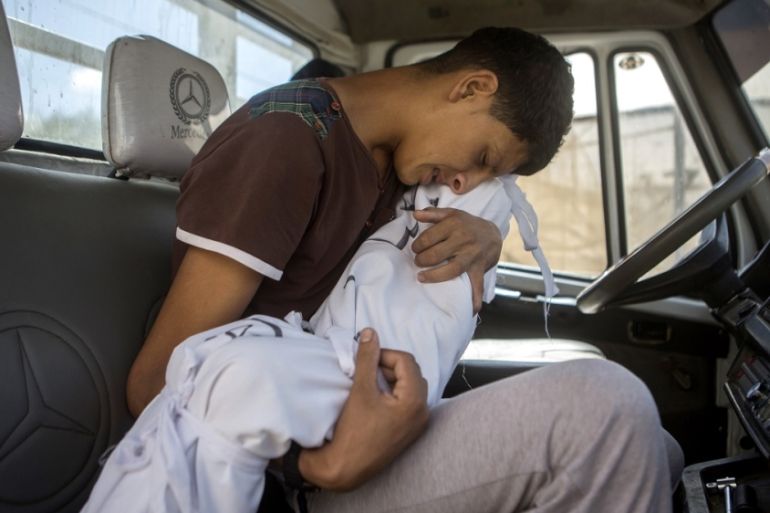‘This photo marked the moment my life ended’: Documenting death in Gaza
A photojournalist tells the story behind an image of a young Palestinian man refusing to let go of the body of his two-year-old niece.

“This photo marked the moment my life ended. She stayed in my arms until we buried her,” said 18-year-old Mohammed Maadi one year after the Israeli bombing in which six members of his family were killed.
I had taken this photo of him near Rafah on August 3, 2014, two days after the bombing. In it, he is holding the dead body of his two-year-old niece, Jana.
Keep reading
list of 4 items‘Children of the Ganges’ — The boatmen of India’s Varanasi
US senators call on Biden to sanction Sudan’s RSF over human rights abuses
Israeli attack kills 10, mostly children, in Gaza’s Rafah
Israel had been heavily and indiscriminately bombing the Palestinian city in response to the capture of an Israeli soldier by Hamas fighters. I had been in the Gaza Strip documenting the victims of the conflict for about three weeks.
Early on the morning of August 3, I had jumped into a car with a few other journalists – a “TV” sign put together with scotch tape had been hastily attached to it – and headed south.
We knew the road would be fraught with danger and drove as quickly as we could. We could hear bombs striking nearby.
My memories of that day are foggy. The lack of sleep was affecting us, on top of the stress and the emotional toll that bearing witness to atrocities can take.
I felt as if I was on auto-pilot: documenting what I could, clicking the camera, taking some notes, putting the images online. We hardly had time to eat or sleep and it was mostly at night, when I was reviewing and editing the photos, that the horror of what we were witnessing each day would hit me.
Still, this particular scene is something I have never forgotten. We had just visited the Kuwaiti Hospital in Rafah, which was struggling to cope with the number of injured and dead, when we were told about another place – a walk-in flower cooler in an agricultural field where dead bodies had been piled up because the morgue and hospitals were full.
I still remember the unbearable smell of bodies decomposing in the summer heat. It sticks to you and does not go away. Bodies on the floor, on shelves. Relatives were trying to find their loved ones, to bring them back to their family and bury them, despite the risk of further attacks.
I still remember the unbearable smell of bodies decomposing in the summer heat. It sticks to you and does not go away. Bodies on the floor, on shelves. Relatives were trying to find their loved ones, to bring them back to their family and bury them, despite the risk of further attacks.
I left the cooler and remember walking past a truck and seeing this young man sitting in the cab, clinging to a little body wrapped in a white sheet with a name written in Arabic on it. I took several photos and he looked at me for a few seconds. A few seconds that felt like an eternity.
What must he have thought of me, a photographer documenting his intense pain?
He looked so broken. I asked someone else from the family what their name was, and I wrote down “Maadi” in my notebook. I later found out that the child he was holding was the daughter of his brother, and that he was refusing to let her go. At that stage, I did not know what had happened to her and was left with many unanswered questions.
I left the Gaza Strip two days later with a heavy heart, worried about the people I was leaving behind.
After the ceasefire, I returned and began work on a collective multimedia project, Obliterated Families, about the families shattered by the 2014 offensive. I knew I had to meet the Maadi family for this.
When I did, I found out how the bombing of their home had resulted in the deaths of six members of the family – Mohammed’s brother, Bassam, 33, Bassam’s wife, Iman, 31, and their two daughters, Hala, 3, and Jana, 2. Two other members of the Maadi family were also killed in that airstrike: two-year-old Yousef, the son of another of Mohammed’s brothers, and Mohammed’s uncle, Suleiman, 53.
It had happened on Friday, August 1, the day that would come to be known as Black Friday, one of the bloodiest days of the Israeli offensive. There had been 31 people inside the large Maadi family home that day.
I was able to identify the young man I had photographed – and learned his name was Mohammed – but he was not there the day I visited. Instead, Ala Qandil, my co-author on the project, was able to meet him later. He had never recovered from the loss of his relatives. We learned that he had also been injured in the bombing but had been rescued by his neighbours. He now suffers from neurological problems and has dropped out of his mechanic school.
In 2017, I went back once more to see the family. This time, I saw Mohammed briefly. He was holding another of his nieces, one who had miraculously survived, and was smiling; a smile that I try also to keep in my memories.
The photo I took of Mohammed and Jana in Rafah still haunts me. In my mind, it will always be associated with pain and the smell of decomposing bodies, with injustice and with broken lives – of the ones who died, but also of the survivors.